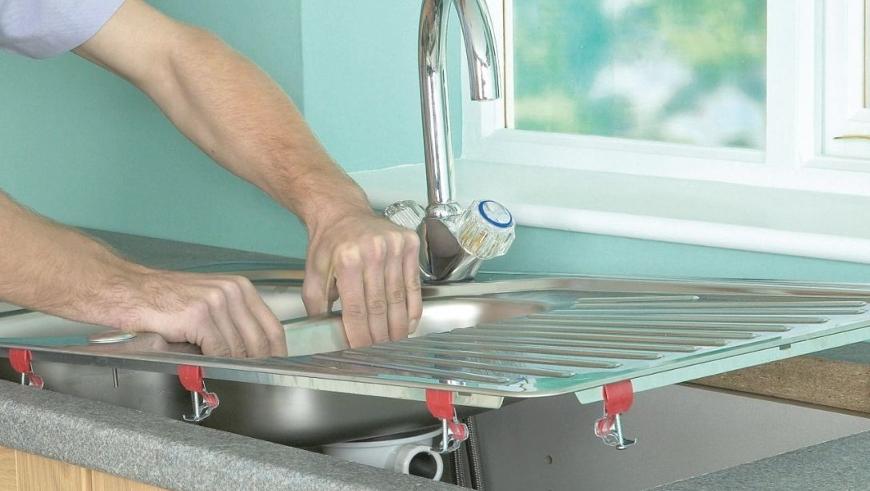Moving Kitchen Sink Cost
Last updated 3rd April, 2024
Wondering the cost of moving a kitchen sink?
This guide will help you if you want to relocate your kitchen sink. We examine all the costs involved from kitchen sink installation cost to sink prices and more!
Continue reading for more information!

How Much to Relocate a Kitchen Sink?
The kitchen sink, a contemplative space for so many of us. No wonder, it is so important that it is in the right position. Whether you want a ceramic Belfast sink by the window, a kitchen island sink in the centre of the room, a granite composite corner sink or a sink in a different room altogether, the location of your kitchen sink is an emotive issue, that can make or break a space.
So what should you expect if you are planning to move a kitchen sink? Although it sounds like a simple job, moving a kitchen sink is probably much more complex than you think. When we consider the prospect of re-modelling any part of a kitchen, we are used to having endless options. However, when it comes to relocating your stainless steel sink, the choices are restricted to a degree by plumbing and drainage considerations.
Any re-positioning of a sink, also involves ensuring that the waste pipe and soil stack are accurately connected to the sink to ensure proper drainage. These two fixtures that we rarely pay any attention too, are the reason that most kitchen sinks are positioned against an outside wall – hence the cliché of the stainless steel sink by the window.
However, plumbing and drainage issues do not mean that moving a sink cannot be done, but it does mean that it can be a tricky, technical and possibly structurally risky job. Depending on the distance moved, the work to relocate a kitchen sink to a central island, for example, is likely to involve digging through the kitchen floor (avoiding important joists), laying new pipes under the floor, configuring new drainage systems to ensure that the waste drains away effectively and at the right angle, digging underneath the house from outside etc.
Such a major piece of work that involves breaking through the kitchen floor, re-locating plumbing and laying new piping, may also require further work to: replace flooring, install kitchen units to hide plumbing, re-plastering, fit new work surfaces, conceal old plumbing and more.
Further, the potential to cause serious damage to your property when you move a kitchen sink are huge. What may have first appeared to be a small re-positioning, can result in long-term structural damage, ongoing drainage issues and further work to dig up your flooring again in future, if not done properly. The consequences of an ill-advised move could be catastrophic. Therefore, it is a good idea to seek a number of professional opinions, from experienced tradesmen, before proceeding with the work.
It is useful to remember that with a new sink in place, you may find that you now have old piping that needs to be hidden, gas or electrical works that need to be dealt with, new workspaces that need to be covered, exposed walls that now need to be painted or additional plumbing costs from extra parts and renovations that are needed to ensure adequate drainage, so it is important to include these extras in any costing.
Kitchen Sink Relocation Prices
The average cost of moving a kitchen sink is around £400 - £750, dependant on the level of plumbing and renovation work that is involved.
Your plumber will usually work at a cost of around £100 – £150 per day.
Below are some estimated costs of hiring a professional plumber to move a kitchen sink:
| Job Description | Avg. Cost | Duration |
|---|---|---|
| Simple Kitchen Sink Relocation | £500-£600 | 1-2 days |
| More complex Kitchen Sink Relocation | £600-£800 | 2-5 days |
| Kitchen Island Relocation | £900-£1200 | 4-8 days |
Cost Breakdown
Individual costs of one basic kitchen sink relocation - Total Cost: £500
Materials
£350
Tradesmen
£100
Waste Removal
£50
FAQs
- • moving walls
- • working in a listed building
- • adjusting the size of doors or windows
- • Stainless steel: For the best value and long-lasting material for a kitchen sink, stainless steel is hard to beat. Stainless steel remains the most popular choice because: it is long-lasting, suitable for frequent use, available in a wide variety of styles and damage-resistant.
- • Fireclay ceramic: For a retro-feel, traditional fireclay ceramic kitchen sinks will last for a lifetime, although they can get chipped, are more expensive and come in a much smaller range of sizes.
- • Natural stone: Granite composite, marble or 100% granite kitchen sinks, provide a beautiful, luxe finish, however, they can damage objects that are fall into them and their heavy density can mean that they require special fittings to install.









